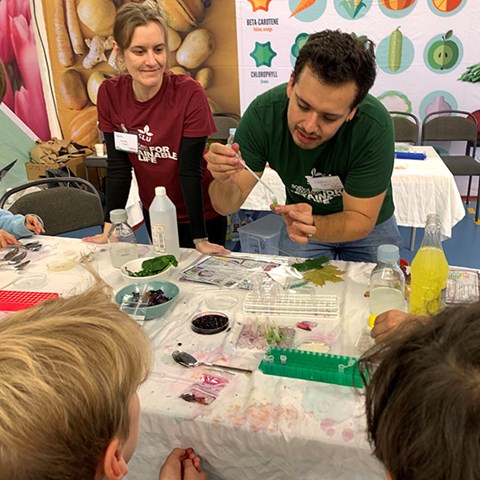School grounds conservation activities create excitement, empathy and fascination in young people

Conservation activities have the potential to empower young people to directly address environmental issues, and to develop a strong connection to a local place, according to Andrew Ruck, researcher at SLU. He studied the British initiative Polli:Nation where school children created pollinator-friendly habitats in their school grounds. Success factors were a relaxed atmosphere, freedom to discover and visits by experts from outside of schools.
Polli:Nation engaged young people aged between 9 and 13 from over 250 schools across the United Kingdom. Conservation activities were different in every school, but commonly included planting pollinator-friendly flowers, planting fruit trees, installing ponds, building and filling “planting boxes” made from various materials, and creating “insect hotels”.
“The project also involved experts brought in to run sessions on specialist skills or topics relevant to a particular school’s Polli:Nation activities. These included staff from conservation charities, volunteers from local wildlife groups, beekeepers, woodwork and landscaping experts, and at least one graffiti artist”, says Andrew Ruck.
He is now employed as a postdoc at SLU, but carried out the research on Polli.Nation as a PhD student at the University of Stirling in Scotland. This research has now led to two papers published in the journal Environmental Education Research. One is based on the authors’ own observations when participating alongside young people in Polli:Nation activities, while the other draws upon focus groups with young people themselves.
A way to address loss of biodiversity
In the papers, the authors argue that projects such as Polli:Nation are an important response to the accelerating global loss of biodiversity. This was recently highlighted by the International Union for the Conservation of Nature (IUCN) , who in October 2019 warned of “unprecedented, unsustainable and growing impacts on wild species from human activities”, and called upon people across the world to “act now to ensure we pass on a rich natural heritage to future generations”. Polli:Nation represented a response to a particular species decline – namely, the decline in pollinator populations due to factors such as habitat loss and pesticide use. School grounds provide considerable space for conservation actions to be taken.
From an environmental education perspective, conservation activities have considerable potential. These activities directly engage young people in a given environmental issue, and enable them to engage repeatedly and in a hands-on manner with a local space. Earlier research in this area has linked the development of pro-environmental attitudes with connection to a place.
Wow-moments and visiting experts
Andrew Ruck and his colleagues concluded that:
- The Polli:Nation project allowed young people to express and develop non-cognitive ways of engaging with the natural world. That is, as well as learning about the science, and the importance of protecting other species, young people were free to express excitement, empathy, fascination, and all sorts of other reactions to encounters with other species. Examples captured in the papers include young people gathering round to peer in fascination at a ladybird, one young person quietly moving a woodlouse out of the way of the rest of the group, and many “wow!” moments as pupils watched bees landing on flowers.
- Visiting experts from outside of school – such as staff from conservation charities - were also a key part of the project, with young people able to ask questions in response to things that they saw, and new and unexpected forms of learning being allowed to taking place. Young people themselves talked a lot about this aspect of the project during focus groups, pointing to the importance of “hearing new voices”, and of “just somebody different… who comes into school to talk about something that we never usually talk about”.
- These two key aspects were enhanced considerably by the relaxed atmosphere that characterised much of the project. While project activities acted as an overarching task to frame the session, the focus was not on getting tasks done in the quickest time possible. Instead, young people experienced a kind of freedom that would not be possible in classrooms, or even sports lessons outdoors. This enabled many of the encounters described above, which were often unplanned. It also enabled young people to ask spontaneous questions, or visiting experts to impart new information, as a response to those encounters.
“The key conclusion from the study is that there is great potential for conservation activities to take place in school grounds, and to form part of school curricula. Wherever possible, however, such projects should try to develop partnerships with people and organisations from the wider community, and retain the ‘relaxed atmosphere’ discussed above”, says Andrew Ruck.
At SLU he is involved in the SHOWCASE project, which focuses on citizen science approaches to monitoring farmland biodiversity, and on participatory research where farmers and researchers co-develop actions to promote biodiversity on farmland.